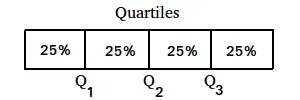Quartiles and interquartile range
Quartiles and interquartile range are among the measures of position. Just like the name indicates, quartiles divide a ranked data (ordered set of data ) into four equal parts. Only three measures are needed to divide any data set into four equal parts.
These three measures that will divide an ordered data set into four equal parts are the first quartile (denoted by Q1), the second quartile (denoted by Q2), and the third quartile (denoted by Q3).
After a data set has been ordered, or written in increasing order, here is how we define the quartiles.
The second quartile or Q2 is the same as the median of the data set after the set has been ordered.
The first quartile or Q1 is the median between the smallest number and the second quartile.
The third quartile or Q3 is the median between the second quartile and the biggest number.
Now, take a look at the following figure and then make the following important observations.

- About 25% of the values in the ranked data set are less than Q1
- You can also say that about 75% of the values in the ranked data set are greater than Q1
- About 75% of the values in the ranked data set are less than Q3
- You could also say that about 25% of the values in the ranked data set are greater than Q3
- About 50% of the values in the ranked data set are smaller than Q2 and about 50% are greater than Q2
Interquartile range
The interquartile range is the difference between third quartile and the first quartile.
IQR = Interquartile range = Q3 - Q1